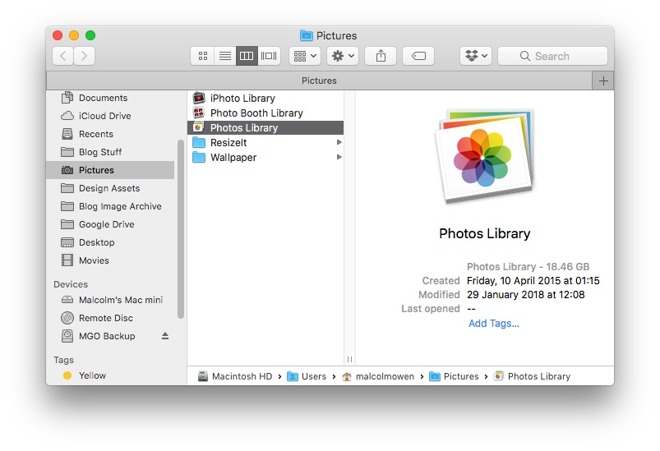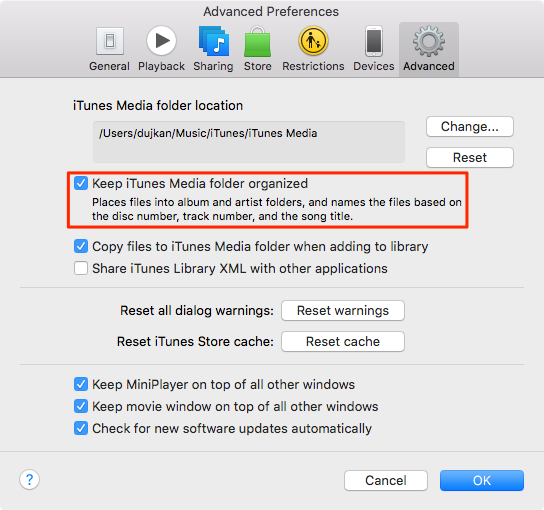Moving Library Folder Items To External Drive Mac
Copy the Thunderbird folder to an external or flash drive, while TB is closed:
- Moving Library Folder Items To External Drive Mac Driver
- Moving Library Folder Items To External Drive Mac And Windows
- Moving Library Folder Items To External Drive Mac Compatible
- Unhide Library Folder Mac
Mar 18, 2020 Your Photos library holds all your photos, albums, slideshows, and print projects. If your library is large, and you want to free up storage space on your Mac, turn on iCloud Photo Library and use Optimize Mac Storage, or move your library to an external drive. Before you start, be sure to. May 23, 2009 Has Your iTunes library become too big to fit on your computer? This video will show you how to move your iTunes media collection to an external hard drive Skill Level: Intermediate Note: for. Copy your Documents folder from your Mac to the external drive; Rename the Documents folder on the Mac to Documents-old; Open Terminal; Type in cd /Users/Your User ID/ Then ln -s /Volumes/External Drive Name/Documents Documents; Test it out for a while to verify that it works, when you are happy with it you can delete the Documents-old folder. Jul 10, 2010 Are your photos in an iPhoto Library? Make sure the drive is formatted Mac OS Extended (Journaled) 1. Quit iPhoto 2. Copy the iPhoto Library from your Pictures Folder to the External Disk. Hold down the option (or alt) key while launching iPhoto. From the resulting menu select 'Choose Library' and navigate to the new location. How to free up your Mac's internal storage by moving your iTunes Library to an external drive. By Malcolm Owen Monday, March 05, 2018, 10:51 am PT (01:51 pm ET). Apr 15, 2017 Moving items in the User's Library to an external drive is not advised. If you need space there are other files like the iPhoto Library and/or Photos Library and the iTunes Library to an external drive. Hold Option key when launching the apps and select the library folder on the external drive.
username > Library > Thunderbird
On the PC, delete the Thunderbird folder in this location if it exists (while TB is closed): C:Users<winusername>AppDataRoaming
AppData is hidden by default; enable Hidden Items on the View tab of File Explorer.
Paste the Thunderbird folder in the Roaming folder. Open the profile folder:
..RoamingThunderbirdProfiles<8charstring>.default
and delete pkcs11.txt (to avoid failed logins). Start TB. If the TB version on the Mac was 60 or lower, and it's 68 on the PC, some of your add-ons, including dictionaries, may be flagged as incompatible, and others may need to update. Send Later and Enigmail both have 68-compatible versions.
After decades of digital music, it's not unlikely if you've amassed quite the collection of music on your computer's hard drive. If your iTunes library is taking up too much space, you can move it off of your local drive and onto an external hard drive without breaking your music collection.
You can also transfer your entire iTunes library from one computer to another if you are migrating to a new Mac.
Moving Library Folder Items To External Drive Mac Driver
Before you start: Back up your Mac
Moving Library Folder Items To External Drive Mac And Windows
Before making major changes to your computer, it's always a good idea to back up your data: The best way to back up your Mac is with a Time Machine routine in place, but you can choose an alternate backup option that's right for you.
What you will need
You will, of course, need the computer your iTunes library is currently on. You will also need the following:
- An external hard drive (and power source, if applicable)
- A USB cable to connect the hard drive to your original Mac
- A power source for your original Mac
- If you're moving to a new computer, your new Mac (and its power cable)
Step 1: Consolidate your library
Over time, it's easy for your music, movies, apps, and other iTunes content to end up stored in various places throughout your computer's hard drive. To ensure that you copy everything from iTunes over to an external hard drive, you should first consolidate your library. Even if you think your library has all your information consolidated already, it can't hurt to do a manual check before moving any data.
Moving Library Folder Items To External Drive Mac Compatible

- Launch iTunes on your Mac.
Click File in the upper left corner of your Mac's screen.
- Hover your cursor over Library in the dropdown menu.
Select Organize Library from the secondary menu.
- Tick the box for Consolidate Files in the window that appears.
Click OK.
This process makes a copy of all files in the iTunes media folder, and leaves the original files in their current location.
Step 2: Move your iTunes Library to an external hard drive
- Quit iTunes.
- Connect your external hard drive to your computer using a USB cable.
- Click on Finder to open a Finder window.
Select your Mac's hard drive.
- Click on the Music folder.
Select iTunes and drag it to the external hard drive.
- Click Authenticate when prompted to give permission to move the iTunes folder.
- Enter your administrator password.
Click OK.
This process could take upwards of an hour or two, depending on how much data stored in your iTunes library.

Step 3: Redirect iTunes to the new location
Once you've transferred a copy of your iTunes library onto an external hard drive, you will need to set a new path for the iTunes app by redirecting it to search the external hard drive for content, rather than your local drive.
- Launch iTunes and hold down the Option Keyat the same time.
Click on Choose Library when the window appears.
- Select your external hard drive under Devices in the Finder sidebar.
- Click on iTunes.
Click Open.
Note: Until you delete the iTunes file on your local hard drive, you can switch which libraries iTunes uses by launching the app and holding down the Option key at the same time.
Step 4: Make sure it worked
If you performed the first three steps correctly, when you open iTunes, it should look the same as it did before. You can double-check to make sure the migration worked by checking the info of any content.
- Launch iTunes.
Select a song, podcast, movie, app, or other content.
- Right-click or Control-click on the song.
- Select Get info from the drop down menu.
Click on the File tab in the info window.
Look under Location to ensure that the content is now being stored under /Volumes/external hard drive name/.. instead of Users/local hard drive name/..
Step 5: Delete the old iTunes library
Once you have transferred a copy of your iTunes library onto an external hard drive and redirected iTunes to the new location, you can delete the iTunes folder on your local hard drive, freeing up space on your Mac.
Note: If you are making a copy to transfer to a new computer, you don't need to perform step 5 unless you want to remove your iTunes library from the old computer.
2008-5-26 Cocoa is supported on Mac OS X via the C library. There is no Cocoa Phidgets library avialable. See the C API manual and the Cocoa examples for more details. Java Java 1.4.2 and higher is supported on Windows, Linux and Mac OS X. Java requires the C library, with JNI extentions compiled in, and the Phidget21.jar java library file. See the Java. 2009-2-1 Built upon lowlevel library higherlevel libraries simpliyusing Phidgets manymore languages. Higherlevel libraries contain only glue logic library,thus making maintenance much easier. Available libraries include: COM,.NET, AS3, Java, Python, Max/MSP libraries. 2019-7-31 Notice: This page contains information for the legacy Phidget21 Library. Phidget21 does not support VINT Phidgets, and will not support any new Phidgets. Phidget21 will be maintained until 2020. We recommend that new projects be developed against the Phidget22 Library. Click on the button in the menu bar to go to the Phidget22 version of this page. How to include phidgets library on mac os. Phidgets are a set of “plug and play” building blocks for low cost USB sensing and control from your PC available from www.phidgets.com. This is a set of FFI bindings for the Phidgets library available for Mac OS X and Linux. There are a set of idiomatic bindings that take the provided API and make it more accessible.
- Quit iTunes.
- Click on Finder to open a Finder window.
Select your Mac's hard drive.
- Click on the Music folder.
Select iTunes and drag it to the trash.
Make sure your external hard drive is connected to your Mac when you launch iTunes from now on. Otherwise, iTunes won't be able to find the files. If that happens, quit iTunes, connect your external hard drive to your computer, and reopen iTunes.
Step 6 [optional]: Move your iTunes library to a new Mac
Once you have your iTunes library on an external hard drive, you can relocate it to a new Mac.
- Quit iTunes on your new Mac.
- Connect your external hard drive to your new Mac using a USB cable.
- Open the external hard drive once it appears on your new Mac's screen.
- Click on Finder on your new Mac to open a Finder window.
Select your new Mac's hard drive.
- Click on the Music folder.
Drag the iTunes folder from your external hard drive into the Music folder on your new Mac.
- Launch iTunes and hold down the Option Keyat the same time.
- Click on Choose Library when the window appears.
Select your local hard drive under Devices in the Finder sidebar.
- Click on the Music folder.
- Click on iTunes.
Click Open.
Any questions?
Do you have any questions or issues with moving your iTunes library onto an external hard drive or onto a new Mac? Let us know in the comments and we'll help you out.
Power upAnker's PowerCore Wireless 10K charger is a battery pack without the fuss
Unhide Library Folder Mac
Cleaning mac library cache free app. Anker is out with a new wireless battery pack that'll keep things ticking along no matter where you are.